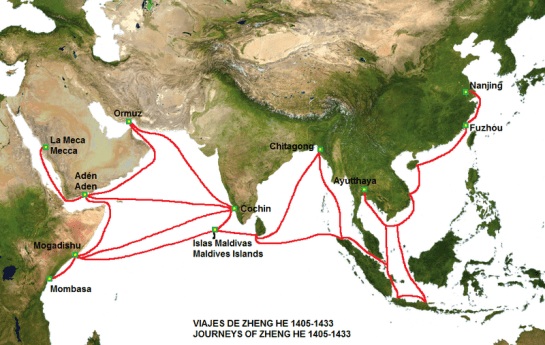![A2Z-BADGE-100 [2017]](https://rolandclarke.com/wp-content/uploads/2017/03/a2z-badge-100-2017.jpg?w=545)
My 2017 A to Z Challenge theme is “The History of Kanata”, the parallel world that is the setting for “Eagle Passage”, my alternative history novel that all began when I wondered, “What would have happened if Leif Eriksson had settled Vinland permanently in 1000 AD? For further details and links to my other A to Z posts – and hints at the ones to come visit “Kanata – A to Z Challenge 2017”.

Y is for Yuan Dynasty: 12 August 1410, Nanjing, Yangtze River – After suppressing the revolts fermented by the Ming invaders, Empress Mandukhai Khatun has secured the Yuan Dynasty with her husband, Batmunkh Dayan Khan, a direct descendant of the great Genghis Khan. Their advisors had encouraged them to adopt the era name Yongle, meaning “perpetual happiness” for that was the age they were entering.
Standing with their courtiers and diplomats aboard the imposing 408-foot, four-decked Imperial junk anchored off the fortress port of Nanjing, they watch they watch the return of Admiral Zheng He’s fleet of 62 treasure ships supported by 190 smaller ships, knowing Zheng’s fourth voyage west had ensured that Chinese dominance of the western trade routes was undisputed with twenty-five fortified ports established to secure the trade routes. Imperial messengers had already announced that the rulers of eighteen countries were sending envoys with the fleet bearing tribute to the Yuan court.
Only the Norse trade network centred in the north remained to be absorbed, or subjugated if they challenged the true heirs of Genghis Khan. However, their distant relations, the Khanate of the Golden Horde had failed to seize any territory held by the Varangians or Rurikids allied to the Norse. The Yuans had a duty to reclaim all the Mongol territory and spread the words of the Buddha.

Author – Continentalis Licensed under the Creative Commons Attribution-Share Alike 3.0 Unported
In our timeline: Source – Wikipedia
The Yuan dynasty was the empire or ruling dynasty of China established by Kublai Khan, leader of the Mongolian Borjigin clan. Although the Mongols had ruled territories including today’s North China for decades, it was not until 1271 that Kublai Khan officially proclaimed the dynasty in the traditional Chinese style, and the conquest was not complete until 1279. His realm was, by this point, isolated from the other khanates and controlled most of present-day China and its surrounding areas, including modern Mongolia.
…The final years of the Yuan dynasty were marked by struggle, famine, and bitterness among the populace. In time, Kublai Khan’s successors lost all influence on other Mongol lands across Asia, while the Mongols beyond the Middle Kingdom saw them as too Chinese. Gradually, they lost influence in China as well…falling to the forces of the Míng dynasty (1368–1644)
Mandukhai Khatun (Mongolian, also known as Mandukhai Sechen Khatun, or Queen Manduhai the Wise, (c. 1449 – 1510) was the Khatun of the Northern Yuan dynasty, that survived the Yuan Dynasty and was based in Mongolia. She reunited the warring Mongols with her husband Batmunkh Dayan Khan, a direct descendant of Genghis Khan.
The treasure voyages were the seven Ming-era maritime voyages between 1405 and 1433. The Yongle Emperor initiated the construction of the treasure fleet in 1403. The grand project resulted in seven far-reaching ocean voyages to the coastal territories and islands in and around the South China Sea, the Indian Ocean, and beyond. Admiral Zheng He was commissioned to command the treasure fleet for the expeditions. Six of the voyages occurred during the Yongle reign (r. 1402–24), while the seventh voyage occurred under the Xuande reign (r. 1425–1435). The first three voyages reached up to Calicut on India’s southwestern coast, while the fourth voyage went as far as Hormuz in the Persian Gulf. Afterwards, the fleet made voyages farther away to the Arabian Peninsula and East Africa.
The Chinese expeditionary fleet was heavily militarised and carried great amounts of treasures, which served to project Chinese power and wealth to the known world. They brought back many foreign ambassadors whose kings and rulers were willing to declare themselves tributaries of China.
Would the Chinese under the Mongolians challenge the Norse trade empire based in Kanata? Would this lead to a naval war? Who would win?
***
Important Links for the A to Z Challenge – please use these links to find other A to Z Bloggers
Website: http://www.a-to-zchallenge.com
Facebook page: https://www.facebook.com/atozchallenge/
Twitter handle: @AprilAtoZ
Twitter hashtag: #atozchallenge
